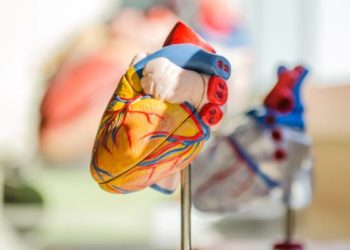#VisualAbstract: Drug-eluting stents for saphenous vein grafts associated with better outcomes than bare-metal stents
1. Among patients who have received a saphenous vein graft during coronary bypass surgery and later experience treatment failure, deployment of a drug-eluting stent during percutaneous coronary intervention leads to more favorable outcomes than does use of a bare-metal stent.
Evidence Rating Level: 1 (Excellent)
Study Rundown: Though it has been shown in previous studies that drug-eluting stents (DES) are associated with more favorable outcomes than bare-metal stents (BMS) when stenting native vessels, data regarding the stenting of saphenous vein grafts (SVGs) is less clear. SVGs are commonly implanted during coronary bypass surgery; due to the relatively high rate of post-operative occlusion, 6% of all percutaneous coronary interventions are performed on SVGs. There is a paucity of data for this particular intervention, some of which is conflicting. A recent trial found no difference in outcome at 12 months between DES and BMS when stenting SVG lesions. To clarify these findings, this study assessed the efficacy and safety of DES among patients undergoing percutaneous coronary intervention in SVG lesions over a longer, five-year period.
In this randomized controlled trial, patients were recruited from six clinical centers in Switzerland, Germany, and Denmark, and randomized 1:1 during coronary intervention to received either a paclitaxel-eluting stent (DES cohort) or a bare-metal stent (BMS cohort). The primary outcome was the incidence of major adverse cardiac events (MACE), defined as the composite of cardiac death, nonfatal myocardial infarction, and target vessel revascularization (TVR) of the stented SVG. At one year, the BMS cohort has a significantly higher incidence of MACE as well as TVR. Furthermore, at the five-year follow-up, incidence of MACE remained significantly in favor of DES. The randomized design of this study lends credence to its findings, though it should be noted that study enrollment was prematurely terminated and thus the study was unpowered, which may have impacted the results. In all, this study suggests that among patients presenting for percutaneous coronary intervention of SVG lesions, the use of DES leads to more favorable outcomes when compared with BMS, and therefore may be the preferred intervention in this population.
Click here to read the study in JAHA
Relevant reading: Drug-eluting stents versus bare-metal stents in saphenous vein grafts: a double-blind, randomised trial
In-depth [randomized controlled trial]: 173 patients with SVG were included in this study, with 89 (mean [SD] age = 70.5 [7.9] years, 89.9% male) randomized to receive DES and 84 (mean [SD] age = 71.4 [8.7] years, 89.3% male) randomized to receive BMS. At one year, the incidence of MACE was significantly higher in the BMS cohort (HR 0.14, 95% CI 0.03 to 0.64, p = 0.01), as was the need for TVR (10.1% vs. 0% in the DES cohort, HR 0.05, 95% CI 0.00 to 0.44, p = 0.003). After adjusting for potential confounders like age, sex, and diabetes mellitus, the advantage of DES in terms of MACE remained significant (HR 0.16, 95% CI 0.03 to 0.71, p = 0.01). At five years, the incidence of MACE continued to favor DES compared with BMS (35.5% vs. 56.1%, HR 0.40, 95% CI 0.23 to 0.68, p < 0.001). When considering the need for TVR, an advantage for patients treated with DES compared with BMS was again demonstrated (13.9% vs. 37.5%, HR 0.23, 95% CI 0.10 to 0.51, p < 0.001). Finally, the need for TVR among patients treated with DES was consistently lower throughout the five-year follow-up period when compared with patients treated with BMS (1-5 years HR 0.33, 95% CI 0.13 to 0.74, p = 0.007). Of note, patients treated with BMS presented more frequently for multiple TVR procedures compared with patients treated with DES (n = 8 [9.5%] vs. n = 1 [1.1%], p = 0.013).
©2020 2 Minute Medicine, Inc. All rights reserved. No works may be reproduced without expressed written consent from 2 Minute Medicine, Inc. Inquire about licensing here. No article should be construed as medical advice and is not intended as such by the authors or by 2 Minute Medicine, Inc.







